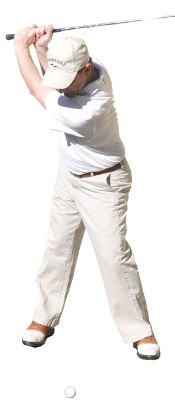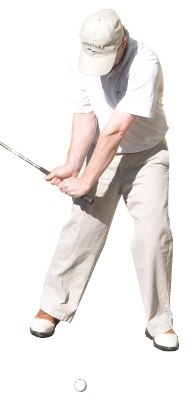
Once considered the heir to Seve Ballesteros and Jose Maria Olazabal among Spanish golf royalty, Sergio Garcia has struggled to live up to expectations – and his own talent. Still, Garcia remains an explosively gifted golfer who can win at any time.
Garcia's swing has changed since his teenage years, when a large downswing loop was its defining feature. While the loop has been tamed, Garcia's swing retains one element that is pretty unique. In fact, it reminds many of the game's all-time greatest ballstriker.
Unconventional move: Garcia's hands remain well ahead of the clubhead very late in the downswing, requiring a lightning-quick unwinding (release) to square the clubface at impact.
Who else does it: Ben Hogan
 Photo 1: At the top of his backswing, Garcia's hands and club are set at an angle similar to his fellow pros.
Photo 1: At the top of his backswing, Garcia's hands and club are set at an angle similar to his fellow pros.
 Photo 2: As he starts down, the angle between arms and shaft becomes more acute. Again, this is a feature of nearly every pro's swing.
Photo 2: As he starts down, the angle between arms and shaft becomes more acute. Again, this is a feature of nearly every pro's swing.
 Photo 3: Here's where Garcia differs from his peers. Where most have unloaded the shaft a great deal by this point, Garcia retains an extreme angle, also called “lag.” Viewed in still or slow motion, it's hard to believe he can actually put the clubface on the ball from here. Somehow, he manages (and manages well). Keen observers say Garcia's swing matches Hogan's more closely in this aspect than any other modern player.
Photo 3: Here's where Garcia differs from his peers. Where most have unloaded the shaft a great deal by this point, Garcia retains an extreme angle, also called “lag.” Viewed in still or slow motion, it's hard to believe he can actually put the clubface on the ball from here. Somehow, he manages (and manages well). Keen observers say Garcia's swing matches Hogan's more closely in this aspect than any other modern player.
Why it's a problem for amateurs: Honestly, most amateurs couldn't achieve this position without injuring themselves. Garcia boasts exceptional flexibility and strength in the arms, wrists and hands. What's more, creating this kind of lag requires a well-synched sequence of lower- and upper-body movements, which few amateurs ever master.
How Garcia gets away with it: It's not the hands, it's the hips. Garcia's hips never lurch toward the ball as they rotate through the downswing, leaving space for his arms to operate. He also turns the hips hard to the left ahead of his upper body and fires the right knee toward the target. This combination – and his freakishly supple wrists – allows Garcia to deliver the club on time, with maximum power.
How you can emulate it: Maintaining a tight arm-to-club angle is a key to hitting long drives and crisp iron shots. Many amateurs release the club far too early, often casting it with the hands to start the downswing.
There are several easy ways to improve your release, including:
- Swinging a weighted club.
- Hitting an impact bag (or beanbag) placed where the ball would normally sit.
- Practicing a partial downswing, holding the angle between the left arm and shaft as you rotate the hips and pull the arms toward the ball.

Sergio Garcia Super Late Release
If you follow professional golf, even casually, you have heard the name Sergio Garcia. Among the best players in the world over the last 15+ years, Garcia has claimed titles in some of the biggest tournaments in the game. Although he hasn't yet managed to bring home a major championship title, Garcia has proved the quality of his play under some of the most pressure packed situations that can be found on a golf course. Specifically, he has been a vital member of the successful European Ryder Cup team on many occasions. Whether he winds up capturing a major title or not before his career comes to a close, there is no doubt that Sergio Garcia will go down as one of the top players of his generation.
One of the defining characteristics of Sergio Garcia's swing is the super late release that he uses to smash the club head into the back of the ball. Unlike many of the other top pros, Garcia is not particularly tall, and he is slight of build. Therefore, he can't use sheer size to power the ball down the fairway – he has to execute a beautiful golf swing that leverages every single bit of power that he has available to him. The swing that he has used throughout his career is truly a sight to behold for any serious golfer. Garcia lags the club possibly better than anyone in the game, and he uses that lag along with a late release to develop plenty of power from his small frame.
To swing the club like Sergio Garcia would take incredible hand-eye coordination, along with a lifetime of practice. If you were to try imitating Garcia's swing move for move, you would likely end up extremely frustrated and disappointed at the end of the process. His swing is truly one of a kind, and you aren't going to find success if you attempt to create a replica of that move in your own game. However, there is certainly a lot you can learn from the way he swings the club, specifically how he holds off the release to the very last moment. Delaying your release can help you to maximize your power, and it can also enable you to strike the ball cleaner than ever before. By maintaining most of the other elements in your swing while simply adding a later release, you may be able to unlock power that you didn't even know you had.
Of course, it should go without saying that you need to work on this late release on the practice range before you attempt it on the golf course. The release phase of your swing is something that happens extremely fast, so you can really consciously think about it as it is taking place. Instead, you need to prepare properly for the release so that it can happen almost automatically. Just like any other adjustment you make to your swing, it is going to take time before you can comfortably use a later release on the golf course with success. Commit yourself to plenty of practice time in order to learn this move and you just might be rewarded in the end with some beautiful golf shots.
All of the content below is based on a right handed golfer. If you happen to play left handed, please take a moment to reverse the directions as necessary.

The Benefits of a Late Release
So what is it about using a late release that can benefit your game? Why does Sergio Garcia work so hard to hold off his release as long as possible? It is all about acceleration. The club head will accelerate to its maximum speed during the release, so you want to save up that speed until the moment of impact has arrived. The vast majority of amateur golfers release the club too early, meaning they will have wasted their maximum swing speed and the club will actually be slowing down as it comes into the ball. If you can hold off that release until you are down near the bottom of the swing, you will be sure to gain distance.
As mentioned above, Garcia is able to produce plenty of power from a small frame thanks to this late release. He has a huge amount of lag in his downswing, and that lag is carried forward until the last possible moment when he turns his hands loose and sends the club into the ball with authority. Garcia can certainly say that he is getting everything out of his swing from a power perspective because he has mastered the late release. Can you say the same thing? If you are like most average golfers, you likely can't make that claim.
It has already been established that a late release can help you max-out your club head speed at the bottom of the swing. While that is likely what most golfers would consider to be the main positive of this swing technique, there are other advantages as well. The following three benefits will each likely be seen in your game after you move to a later release.
- Downward angle of attack. Hitting down on the ball, especially with your irons, is one of the most important skills in the game. You will never strike quality shots without hitting down through the ball aggressively, and a late release will help you do just that. Since you will be holding off the club head until your hands are down near the hitting area, the club head will be attacking from a higher position than it would have been if you released the club earlier in the downswing. In fact, if you watch Sergio Garcia hit shots during a tournament, he even hits down through the ball with is fairway woods. While you probably won't quite ever reach that level of late release, holding the club off as long as possible will help you achieve a powerful downward strike.
- Deal with a variety of lies. If you try to pick the ball off of the top of the ground, you will need to have a good lie in order to hit a quality shot. However, if you hit down through the ball using a late release, you should be able to deal successfully with a wider variety of situations. You are bound to run into poor lies as you make your way around the golf course, so it is to your advantage to be able to produce good shots even when the lie is less than ideal. Whether you are sitting on a bare spot of ground, or your ball is sitting down in some longer grass, a late release will make it easier to overcome this type of adversity.
- Penetrating ball flight. In addition to poor lies, you will also run into poor weather conditions from time to time on the course. When the wind comes up or the rain starts to fall, you want to be able to hit a penetrating ball flight that will still works its way toward the target despite the difficult conditions. Using a late release is a great way to produce a low launch angle with plenty of spin – a great condition for a shot that cuts through the air and holds it line nicely. Scooping the ball up off the ground with an early release with lead to a floating, weak ball flight which will be difficult to predict. Rather than trying to figure out which direction your ball is going to go from shot to shot, hold on to your late release and take some of the guesswork out of the equation.
There really isn't anything bad to say about using a late release in your golf swing. In addition to offering more power, the late release should help you use a nice downward angle of attack in order to produce accurate and penetrating shots from a variety of lies.

The Right Hand is the Enemy
As you already know, both your right and left hand should be on the club while you are making a swing. However, did you know that these hands actually have very different jobs to do within the swing? You shouldn't be using each hand in the same way, because they don't have the same effect over the movement of the club. In terms of creating a super late release in your downswing, you should actually think of your right hand as the enemy. If you can avoid letting your right hand get involved in the swing too early, you will be able to produce a late release – it not, you will be destined to always release the club head prematurely.
The left side of your body should be in control of the swing as you transition from backswing to downswing. That means that your left hip should be turning toward the target, and your left hand should be in control of the club. During the downswing, your right hand is basically just along for the ride. It is your body that is providing power to the swing, and it is your left hand that is guiding the club into position for the strike. The right hand isn't going to do anything in a good golf swing until the very last moment when it will initiate the release.
Almost every amateur golfer that you run across at your local course is using their right hand too early in the downswing. Among swing problems that are faced by the average golfer, an overactive right hand is near the very top of the list. When you watch other people hit shots on the driving range, do you see a lot of people dealing with a slice? If so, you can bet that most of them are slicing the ball due to an early release and an overactive right hand. The reason you don't see professional golfers dealing with a slice is because they understand how to hold off the release until the club is in position to attack from the right angle. Releasing the club at the top of the swing will put the club outside of the correct plane – meaning an outside-in strike and a slice are the only possible outcome.
Taking your right hand out of the downswing is one of the most challenging, and rewarding, things that you can do as a golfer. When first getting started with this technique, you will probably feel like you are going to completely miss the ball. There is a sense of security and comfort that comes with release the club early, which is why most amateur players swing this way to begin with. You have to step out of your comfort zone in order to get better, meaning that you will need to trust the late release on the driving range if you hope to every take it out onto the course. Hold off your release in the downswing and take your right hand along for the ride as long as possible.

Learn to Pitch the Ball
Practicing your pitch shots is a powerful way to improve your game for a number of reasons. First, practicing pitch shots will help you on the course when you put your ball in an awkward spot somewhere between 30 and 60 yards from the hole. Also, the pitch swing is basically a miniature version of the full swing, so improving your technique from short range is very likely to help your golf swing as a whole.
That is certainly true when it comes to trying to learn the late release. If you are having trouble feeling the right moves on the range to use a late release in your full swing, head over to the short game practice area and hit some pitches. By pitching the ball over and over, you should be able to feel how your right hand can stay out of the picture while your left side leads the hit. In fact, you may want to hit a few practice pitch shots with only your left hand on the club in order to get a better feeling for how the release can work.
Since the pitching motion is smaller and slower than a full swing, it will be easier for you to focus on the basics of your technique while delaying the release. Once you start to get comfortable with a late release, you can gradually work your way up to hitting longer and longer shots on the driving range. Eventually, you should be able to hit your driver on the range while still employing the late release that you learned with your pitch shots.
While you are pitching the ball, remember to work on hitting down through your shots. Even on a short pitch, you should still be taking a small divot after you make contact with the ball. Watch how your ball reacts when it lands on the green – if you are hitting down nicely, there should be a fair amount of backspin on the ball which will cause it to bounce just once or twice before coming to a stop. Many golfers never learn how to pitch the ball this way, which has a lot to do with why many players are never able to use the late release in the full swing.
Another point to pay attention to while working on pitch shots is your grip pressure. Your hands – specifically, your right hand – should be placed lightly on the grip of the club at address. You want to have just enough tension in your hands to control the club through the hitting area, and no more. If your right hand is tight around the grip, it is going to want to get involved actively in the downswing – and you should now understand why that is a problem. Allow your fingers to remain relaxed around the grip while the weight of the club moves back and through the shot. As your swing gets bigger and bigger, maintain your focus on grip pressure so you can find the perfect balance between control and freedom.
You might be surprised at how quickly you can improve your late release just by hitting some practice pitch shots. If you are able, try to go back and forth between pitch shots and full swings so you can successfully translate the technique from one area of the game to the other. In the end, both your pitching and your full swing should be improved due to the time and effort that you have put into the process of searching for a late release.

Developing Trust
Perhaps more than any other part of the golf swing, the late release takes trust. Without the trust in yourself to execute this technique properly, your mind and body will default back to your old way of swinging the club. At first, you won't even trust this technique on the driving range, and it will take some time before you are able to consistently produce good practice shots when using a super late release. However, once that hurdle is cleared and you are comfortable with this type of swing on the range, you will then need to bridge the gap from the range to the course. That is likely the biggest hurdle of all that you will need to deal with, as moving a new swing technique out onto the course requires a tremendous amount of confidence and belief in yourself.
So what can you do in order to make sure you have plenty of belief when it comes time to test this new release style on the first tee and beyond? The first thing you can do is make sure you have invested plenty of practice time. It isn't going to be enough to simply spend one or two practice sessions working on the late release prior to walking out to the course. Most likely, this is a process that will require weeks or months before you can reasonably expect to see good shots time after time. Don't rush the process – be honest with yourself and only book a tee time when you feel completely prepared.
Another way to build trust and belief in this new swing is to 'play' your favorite course while you are still on the driving range. That means that you are going to hit all of the shots required on your favorite course while you are working through a practice session. This drill will allow you to prove to yourself that you are able to produce all of the shots needed to get around the course while using a late release.
To get started, picture the first hole of your favorite course and select the club that you would use for the tee shot. After you have hit that first shot, picture the approach shot to the green and again select the right club for the job. Repeat this process until you have worked your way around all 18 holes (skipping the short game shots, obviously). This is a great way to go through a bucket of balls, and will help you to feel better about your chances when you actually play the course that you were just picturing in your mind. Having seen how you hit the necessary shots on the range, your mind will have a reason to feel confident when you decide to test out this new swing for real.
Anyone expecting to suddenly turn into a ball striker of Sergio Garcia's quality after working on a late release is going to be sorely disappointed. Garcia is among the best ball strikers in golf history – expecting to perform at his level is completely unrealistic. However, you certainly can learn from the way he holds off the release. Work on delaying your downswing release as long as possible and your ball striking ability should quickly improve. With more power and a better angle of attack now present in your swing, you just might be surprised to learn what you are capable of doing on the course.






